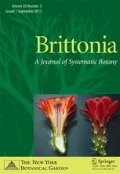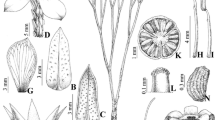Abstract
A new species of Miconia from the mountains in the Atlantic Forest of eastern Brazil is presented here. Miconia atlantica has been collected in the states of São Paulo and Espírito Santo. It belongs to section Glossocentrum and can be recognized among others species in this section by the leaves with acute bases, an indumentum consisting of stellate trichomes moderately covering the abaxial surface of mature leaves, glomerulate inflorescences, and stamens with unappendaged connectives. Marsupiform domatia were found in São Paulo populations.



Similar content being viewed by others
Literature Cited
Baumgratz, J. F. A., K. F. R. Bernardo, B. Chiavegatto, R. Goldenberg, P. J. F. Guimarães, R. Kriebel, A. B. Martins, F. A. Michelangeli, M. Reginato, R. Romero, M.L.D.R. Souza, & E. Woodgyer. 2012. Melastomataceae. In: Lista de espécies da flora do Brasil. Jardim Botânico do Rio de Janeiro. (http://floradobrasil.jbrj.gov.br/2012/FB000161).
Carvalho L. L. C., M. R. Boeger, A. F. Brito & R. Goldenberg. 2012. Morfologia das domácias foliares de Miconia sellowiana Naudin (Melastomataceae). Biotemas 25: 19–9.
Cogniaux, A. 1891. Melastomataceae. In: A. P. de Candolle & C. de Candolle (eds.), G. Masson, Paris.
Heywood V. H. 1993. Flowering plants of the world. B.T. Bastford, London.
Goldenberg, R. 2000. O gênero Miconia Ruiz & Pav. (Melastomataceae): I. Listagens analíticas, II. Revisão taxonômica da seção Hypoxanthus (Rich. ex DC.) Hook F. PhD thesis. Universidade Estadual de Campinas, Campinas.
———. 2004. O gênero Miconia (Melastmataceae) no Estado do Paraná, Brasil. Acta Botanica Brasilica 18: 927–947.
———. 2009. Miconia. In: M. G. L. Wanderley, G. J. Shepherd, T. S. Melhem, A. M. Giulietti & S. E. Martins. Flora Fanerogâmica do Estado de São Paulo, v. 6. Instituto de Botânica, FAPESP, São Paulo. 73–103.
——— & A. M. Amorim. 2006. Physeterostemon (Melastomataceae): a new genus and two new species from the Bahian Atlantic Forest, Brazil. Taxon 55: 965–972.
——— & M. Reginato. 2006. Sinopse da família Melastomataceae na Estação Biológica de Santa Lúcia, Santa Teresa, Espírito Santo. Boletim do Museu de Biologia Mello Leitão 19: 31–56.
———, D. S. Penneys, F. Almeda, W. S. Judd, & F. A. Michelangeli. 2008. Phylogeny of Miconia (Melastomataceae): patterns of stamen diversification in a megadiverse Neotropical genus. International Journal of Plant Sciences 169: 963–979.
Judd, W. S. 2007.Revision of Miconia sect. Chaenopleura (Miconieae, Melastomataceae) in the Greater Antilles. Systematic Botany Monographs 81: 1–235.
Martin, C. V., Little, D. P., Goldenberg, R., Michelangeli, F. M. 2008. A phylogenetic evaluation of Leandra (Miconieae, Melastomataceae): a polyphyletic genus where the seeds tell the story, not the petals. Cladistics 24: 315–327.
Michelangeli, F. A., D. S. Penneys, J. Giza, D. Soltis, M. H. Hils, & J. D. Skean. 2004. A preliminary phylogeny of the tribe Miconieae (Melastomataceae) based on nrITS sequence data and its implications on inflorescence position. Taxon 53: 279–290.
Myers N., R. A. Mittermeier, C. G. Mittermeier, G. A. B. Fonseca & J. Kent. 2000. Biodiversity hotspots for conservation priorities. Nature 403: 853–858
Renner S.S. 2004. Melastomataceae. In: N. Smith, S.A. Mori, A. Henderson, D.W. Stevenson & S.V. Heald (eds). Flowering plants of the neotropics. Princeton University Press, Princeton.
Ribeiro M. C., J. P. Metzger, A. C. Martensen, F. J. Ponzoni & M. M. Hirota. 2009. The Brazilian Atlantic Forest: How much is left, and how is the remaining forest distributed? Implications for conservation. Biological Conservation 142: 1141–1153.
Stehmann J. R., R. C. Forzza, A. Salino, M. Sobral, D. P. Costa & L. H. Y. Kamino. 2009. Plantas da floresta Atlântica. Rio de Janeiro: Jardim Botânico do Rio de Janeiro.
Acknowledgments
We thank L. S. Pereira and G. Lunhani for fieldwork guidance; Diana Carneiro for the line drawings; and the two manuscript reviewers. The authors are recipients of a Ph.D. scholarship (MKC) and a “Produtividade em Pesquisa” grant (RG) from CNPq.
Author information
Authors and Affiliations
Corresponding author
Rights and permissions
About this article
Cite this article
Caddah, M.K., Goldenberg, R. Miconia atlantica, a new species of Melastomataceae from the eastern mountains of Brazil. Brittonia 65, 351–356 (2013). https://doi.org/10.1007/s12228-012-9291-8
Published:
Issue Date:
DOI: https://doi.org/10.1007/s12228-012-9291-8




